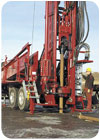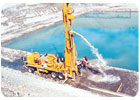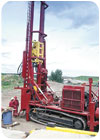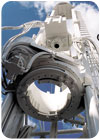
The primary distinguishing feature of a dual rotary rig is a lower rotary drive that is used to advance steel casing.
The dual rotary drilling concept was developed by Barber Industries and commercialized with the introduction of a dual rotary rig in 1979. In 1993, this technology was acquired by Foremost Industries LP of Calgary, Alberta.

The dual rotary concept works in a broad range of applications.
The primary distinguishing feature of a dual rotary drill rig is a lower rotary drive that is used to advance steel casing through unconsolidated overburden. Rotational forces are transmitted to the casing via power-operated jaws. A carbide-studded shoe, welded to the end of the first piece of casing, enables the casing to cut its way through the overburden. A top-drive rotary head simultaneously handles a drill string equipped with either a down-the-hole hammer, drag bit or rolling cone bit to drill the center.
Initially, the dual rotary technique was perfected for use in water well and construction applications. In recent years, the technology has evolved, and new rigs and design features have improved performance and broadened its range of applications.

In typical drilling operations, the drill bit is advanced slightly ahead of the casing.
Some Background
The cable tool (percussion) method of drilling holes has been used successfully for overburden and hard rock drilling for centuries. In 1948, Wendell Reich is credited with revolutionizing the well drilling industry with the development of a top-drive rotary rig with hydraulic pull-down capabilities. The next major advancement in drilling productivity came with the introduction of the down-hole hammer. These two events contributed significantly to the state of hard rock drilling, as we know it today. However, technical progress in overburden drilling has not been as spectacular. Drilling holes in overburden and unconsolidated formations, due to unpredictable variations, continues to present drillers worldwide with challenges such as loss of circulation, boulders, unstable walls, crooked holes, aquifer contamination and heaving sands. While a variety of overburden drilling methods exist, historically none has been consistently able to overcome all of these challenges. In 1979, Barber Industries, in conjunction with Wendell Reich, conceptualized and built a rig that simultaneously could drill a hole and set casing under the most difficult of drilling conditions and subsequently introduced the first dual rotary drilling rig.
Safe and efficient loading and unloading.
Independent Operation
The distinguishing feature of a dual rotary rig is a lower rotary drive, which is used to independently advance casing up to 40 inches, depending on the drill model. The lower drive transmits pulldown, pullback and rotational forces to the casing. A carbide-studded shoe, welded to the bottom casing joint, cuts through the overburden. The rotary top drive has its own feed system, and raises and lowers independently of the lower drive.The rotary top drive handles the inner drill string, which can be tooled with a down-hole hammer, drag bit or rolling cone bit. Cuttings typically are removed using air from either the on-board compressor or an auxiliary compressor. Because the top drive and lower drive operate independently of one another, the drill bit can be positioned ahead or behind the casing shoe. For example, the casing can be advanced ahead of the drill bit, minimizing aquifer cross-contamination and loss circulation, and eliminating borehole stability problems associated with artesian conditions. In typical drilling operations, the drill bit is advanced slightly ahead of the casing for fastest penetration rates. It is worth noting that once the casing is chucked in the lower drive, it can be rotated either clockwise or counter-clockwise. Once the casing has been set to the required depth, the dual rotary drill can continue to drill open hole in the same manner as a conventional top-drive air drill without tripping out to change the bit.

The lower drive feeds on two directly connected hydraulic cylinders (outside left and right). The top-drive feeds on a separate cylinder in the center.
Hydraulic Feed System -Both the top and lower drive units are raised and lowered via directly connected hydraulic cylinders. Benefits of this design include a high pullback to weight ratio, zero load on the mast's crown, and the elimination of cables, chains, sheaves and sprockets in the feed system for reduced maintenance issues.
Breakout Using Lower Drive -In addition to providing the feed and rotation needed to advance casing, the powerful lower drive is used to make and break tool joints, hammers and bits.
Tilt-out Top Drive -The top drive has a hydraulic tilt-out feature that enables safe and efficient loading and unloading of drill pipe and casing. Some models are available with an optional pipe tub and single rod loader.
Cuttings Discharge Swivel -All cuttings that rise up the annulus between the drill pipe and casing are diverted through a discharge swivel, which attaches to the top of the casing. An integral bearing, protected by patented hard metal seals, provides support between the rotating casing and stationary discharge elbow. A cone seal prevents cuttings from blowing by as the drill pipe rotates. Cuttings are directed by a flexible hose to a convenient dumping point or optional sampling cyclone.
Casing Shoe -A carbide-studded shoe, welded onto the casing, cuts through boulders and hard formations as the casing rotates. This shoe also enables the dual rotary drill to seat casing into bedrock. It is important to note that casing shoes used with dual rotary systems have the same inside diameter as the casing. Consequently, there is no reduction in the borehole diameter when switching to open hole drilling. The outside diameter of the casing shoe is fractionally larger than the casing for reduced friction on the outer wall of the casing. Casing shoes are available in light duty, standard duty and heavy duty, and are distinguished by the spacing of the carbide buttons.
Casing Jaws -The lower rotary drive engages the casing via a set of three power-activated casing jaws. Once the casing is locked in the jaws, it can be rotated clockwise or counter-clockwise while simultaneously applying pulldown or pullback. The hardened steel jaws are available for all common casing sizes and feature replaceable pipe tong inserts.
The lower drive design enables the jaws to be changed out quickly in the field.
ND
Report Abusive Comment